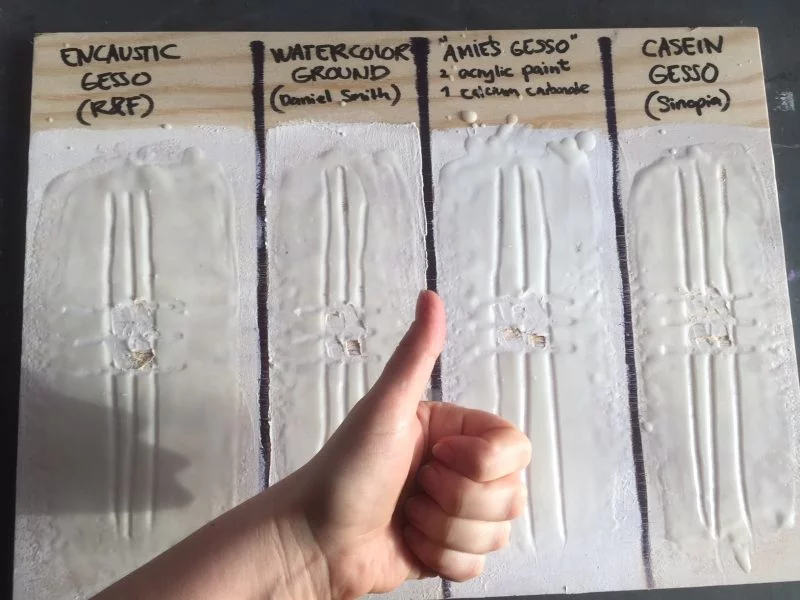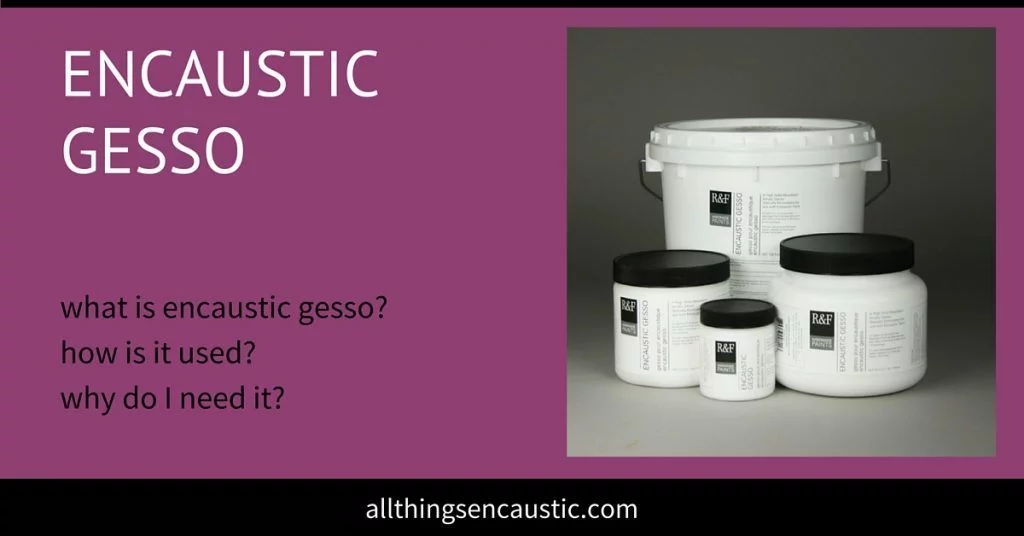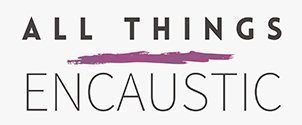When I want to know things I tend to go to the bottom and gather knowledge and experience from different sources. Then I try out the facts/statements in my own practice. For me it’s important to not just know how things work, but also why.
So now I have painted with encaustic for some time and feel I have pretty much a good picture of the basics. In most areas, except one. A discussed topic with a lot of different opinions. I guess tradition is interfering with new approaches. Good old facts are challenged by new science. And who’s right?
What types of Gesso are suitable for Encaustic Painting?
As I wrote in the title, I want to know what types of gesso are suitable for encaustic painting. R&F has done an excellent review of this. You can read the whole report here:
But the short summary is that they used the often referred to “freezer test” to determine what substrate is suitable for encaustic painting.
Alternative Grounds
You may wonder, if R&F has already done this, why am I conducting my own test? Well, I wanted to try out three grounds that R&F didn’t test.
- Casein gesso?
- My own acrylic gesso?
- Water colour ground?
Casein gesso?
Casein is what I mostly use and a lot of other encaustic artist as well. I wanted to be sure before I sell paintings that I state facts I know I can stand for.
Acrylic gesso?!?
A somewhat hot subject to enter in the world of encaustic. Let me assure you, I have had a conversation with R&F about this topic. R&F encaustic gesso is an acrylic gesso. R&F claims that acrylic is not just good but excellent as an encaustic gesso, IF you understand the chemistry behind it…
“What is missing in this common assumption about acrylic is an understanding of the ratio of binder to solid.” R&F Handmade Paints
So to say this out loud: normal acrylic paint is not good as gesso for encaustic. But… if the ratio of binder to solid is lower it makes the acrylic not just good but perfect for encaustic.
Try it!
This made me ask R&F what they thought of watercolour ground, an acrylic ground with a lot of absorbing material in it. R&F told me to try it.
I then asked about a homemade recipe of watercolour ground with acrylic and marble dust (calcium carbonate). And they answered again that I should try it. R&F encourages artists own experimentation. They also encouraged me to post my results. So here I go.
Preparing Grounds for Testing
I prepared a plywood surface with four different types of gesso grounds.
- R&F encaustic gesso (as a test reference)
- Watercolour ground (Daniel Smith)
- My own acrylic gesso (2 part cheap white acrylic paint and 1 part calcium carbonate)
- Casein gesso (Sinopia)

The Freezer Test
- Following R&F’s tips, I let the painted board rest until the next day.
- Then I painted each with my own encaustic medium (1:8 ratio) four times, fusing in between of course.
- I put the test boards in the freezer for about an hour. (By the way it didn’t crack in the freezer.)
- Back to room temperature for at least four hours.
- And then SLAM. Hard. Really hard. Four times on a concrete floor.
The Results

Not a mark. The encaustic was stuck solid hard on the board. On all four surfaces.
Then I scraped the surface and even gouged the wax loose hard with a screw driver. Same on all four surfaces. Really good adhesion. I didn’t proceed with all the steps R&F did in their test, this was enough to convince me.
So I can’t of course say anything about how acrylic encaustic gesso will perform after 50 or 500 years but that it works right now is beyond my doubt.

Try it yourself
Please copy my test and try it yourself. Then please post your results in the comments below.
If cheap acrylic paint with some pretty cheap marble dust (calcium carbonate) can make a good ground for encaustic, a lot of poor encaustic artists will sing out loud. Hurray for science and art!






I am new to encaustic… just starting actually…
I plan to use cheap white acrylic paint and calcium carbonate as per your option.
Is white acrylic house paint ok? And you say 2 parts to one.. is that by volume?
Thanks
Pauline
I’m very curious about your mixing acrylic paint with marble dust. You mentioned a two part acrylic paint to one part marble dust. How are you measuring the proportions? Weighing both? Eyeballing it? You also mentioned it makes a thick mixture that you can’t add too much water to, or the results were bad. Have you tried using marble dust with high flow acrylics? The reason for my questions is I love gelli plate printing and want use gelli plate prints under my encaustic wax paintings. I would glue them to a wooden panel first. So I am searching for a thin, porous, rollable (with brayer), acrylic paint that encaustic wax will stay adhered to. Thanks so much for all your wonderful information!!!!!!!! -Aimee
Hi, I have not painted for some years. Nice that you are tying something new! Do a freezer test with your own colours and you will se if it works. Good luck!
Hi Amie
I work on large panels and use chalk paint instead of gesso as its too expensive. What are your thoughts on adding calcium carbonate and pva glue to chalk paint to make a stronger gesso? I would appreciate your advice. Sarah NZ
I have my encaustic layer first, then painted with oil stick. How and is it necessary, to applied wax over the oil stick. I tried this once and the wax was just too thick. My temp. Is at 200, I had to scrape off some wax in order to see the painting and ended up removing the painting in some areas which is undesirable. Thanks L.A. Green
Hi Leann,
Check out this post – https://allthingsencaustic.com/pigment-sticks-encaustic/ which explains about using oil sticks with encaustic.
Can anyone tell me if I can use encaustic wax over a gilded gessoed ( rabbit skin glue with calcium carbonate) surface sealed with shellac? I would like to sgraffito the design over the gold but am not sure if shellac would be the best barrier to prevent the gold from being scraped off.
Can you please give specific details for your homemade formula? How much acrylic paint (brand and amount) to how much marble dust (I believe that is calcium carbonate).
Thanks so much!
Hi Sharon!
Sorry but I can’t give any exact details for my acrylic encaustic gesso. I used Pebeo white acrylic paint but can’t see any issue with using any other brand. An expensive one would just be a waste of money… Acrylic paints, cheap or expensive, are quite the same thing (not as oil paints when quality really differs with price). Some have used acrylic gesso instead of paint and said it failed. I don’t know why or if it was bad luck. Maybe it works as well. We just have to experiment and se the results.
As I wrote I used about one third of calcium carbonate with the acrylic paint. Maybe you can use less with the same effect? Just try! But I would not recommend more. The mixture was quite thick and acrylic paint should not be deluded more then 30-50 percentage or the binder (in the paint) will not be able to hold the paint together. Hope this gives you some answer to your question.
I’m curious why you would not include Evans Encaustics Holy Grail Encaustic Gesso made specifically for encaustics.
She was testing her homemade products to see if they would work, she wasn’t testing commercially available encaustic gesso. The R&F Gesso was just used as a test reference. There’s no question, Evan’s Holy Grail Encaustic Gesso would also work.
Fantastic article, have you ever tested drywall mud on the substrate?
Hi Lynn, thank you for liking the article! But I’m sorry I have not tested drywall mud. As I understand there are a lot of different brands with different ingredients. So it would be hard to say anything generally about it. Either that I have read about R&F warning about using plaster because it’s too absorbent. I could think that could apply about drywall mud as well. But still there are encaustic artist using plaster… so maybe there is a trick. Experiment and use the freezer test to determine the adhesion. Art is all about finding new ways. Good luck!
Hi K, I think Ruth made a great response on your question. I used R&F encaustic gesso as a reference because it’s made of acrylic and they had tested it to perform great with encaustic. My curiosity was on how to make DIY encaustic acrylic gesso that performs at least good. Why I included Casein gesso was simply because that’s what I use a lot and R&F had not declared the brand I use and I wanted to see if it was good as R&F gesso. And of course I want to inspire others to do their own testing – so go on and try any brand or ideas you have!
Thank you for taking the “freezer test” on the various products. And thank you for publishing the results. I had never heard of the freezer test but will also try testing the products I am using with this method. I tend to put four layers of hot wax on bare wood panels; fusing each layer, prior to adding any other medium such as RF and other companies’ encaustic paints as well as encaustic paint I have mixed myself. Although encaustic is one of the oldest mediums, today’s use is fairly new. Science and testing may prove that some of the old ideas are myths today.
Thank you Sylvia for your response! Art and science are all about experimenting and finding new paths. Traditions are great to listen and learn from and sometimes they hold great secrets but as you say: sometimes it’s good to know that eating led is no health cure
I have been making a milk paint for my gesso- equal parts baking soda, milk powder, and water then I add either white pigment powder or acrylic paint to make it whiter. Usually a spoonful of pigment or 1/8 cup or so of white acrylic. It has been great for a thin gesso.
Have you tried a freezer test Judy to see how well your encaustic adheres?
Sounds interesting… but as a science teacher I would be concerned about the baking soda/sodium bicarbonate because it decomposes by heat and water. In longlivity maybe a painting exposed to heat and humidity can make the gesso to loose its ability to adhere to the wood. This is just me thinking and no solid facts… but it also makes it clear that the freezer test doesn’t tell how a gesso will perform over time and under different conditions… (Marble dust/calcium carbonate is not soluble in water)